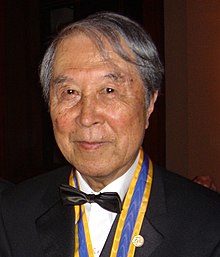Yōichirō Nambu
Yōichirō Nambu ( Japanese 南部 陽 一郎 , Nambu Yōichirō ; born January 18, 1921 in Tokyo , † July 5, 2015 in Osaka ) was an American physicist of Japanese origin. On October 7, 2008, he was awarded the Nobel Prize in Physics .
Life
Nambu studied at the University of Tokyo and received his doctorate there in 1952. He was professor of physics at the Municipal University of Osaka and then at the Enrico Fermi Institute at the University of Chicago .
He became known in 1965 through the so-called Han-Nambu model , which defined the color charge as an additional quark property (with Moo-Young Han , O. W. Greenberg also did this independently ). He is also known for the quantum field theoretical Nambu-Jona-Lasinio model (with Giovanni Jona-Lasinio ), which shows dynamic breaking of chiral symmetry and is modeled on the BCS theory of superconductivity (he also later worked on such models for mass generation of fermions ), and for early work on spontaneous symmetry breaking (sometimes the Goldstone boson is also called the Nambu-Goldstone boson) (1961).
With the discovery (around 1970) that the dual resonance model of the strong interaction can be explained by a quantum mechanical model of strings, he is considered to be one of the fathers of string theory . In string theory, the Nambu-Goto effect of a bosonic string is named after him. At the end of the 1970s, he also dealt with string and topological suggestions in quantum chromodynamics in order to find an explanation of the confinement behavior. Many other original ideas in elementary particle physics come from him.
Together with Makoto Kobayashi and Toshihide Masukawa , he was awarded the Nobel Prize for Physics on October 7, 2008, “for the discovery of the mechanism of spontaneous symmetry breaking in elementary particle physics ”. As he was unable to attend the award ceremony in Stockholm for health reasons, he received his medal and Nobel diploma on December 10, 2008 during a ceremony at the Fermi Institute by the Swedish Ambassador Jonas Hafström . His Nobel Prize lecture was given by the Italian physicist Giovanni Jona-Lasinio .
Awards
- 1970: Dannie Heineman Prize for Mathematical Physics
- 1973: Member of the American Academy of Arts and Sciences
- 1973: Member of the National Academy of Sciences
- 1976: J. Robert Oppenheimer Memorial Prize
- 1978: Order of Culture (Japan)
- 1982: National Medal of Science
- 1985: Max Planck Medal
- 1986: Dirac Medal (ICTP)
- 1994: Sakurai Prize
- 1994/5: Wolf Prize
- 2005: Oskar Klein Medal
- 2005: Benjamin Franklin Medal
- 2007: Pomeranchuk Prize
- 2008: Nobel Prize in Physics
Fonts
- Broken symmetry. Selected papers . World Scientific 1995 (Eguchi, Nishijima eds.)
- with Giovanni Jona-Lasinio : A dynamical model of elementary particles based on an analogy with superconductivity . Part 1, In: Physical Review. Volume 122, 1961, p. 345, part 2 in Volume 124, 1961, p. 246
- with MY Han: A three triplet model with double SU (3) symmetry. In: Physical Review. Volume 130, 1965, p. B 1006
- QCD and the string model. In: Physics Letters. Volume B 80, 1979, p. 372
- BCS mechanism, quasi supersymmetry and fermion masses. In: Ajduk (ed.): New theories in physics. Warsaw 1988
- Fermion-Boson relations in BCS-type theories. In: Physica . Volume D 15, 1985, p. 173
- Symmetry breakdown and small mass bosons. In: Fields and Quanta. Volume 1, 1970, p. 33 (history of the Higgs mechanism)
literature
- Michael S. Turner : Yoichiro Nambu (1921-2015). In: Nature . Volume 524, No. 7566, 2015, p. 416, doi: 10.1038 / 524416a
- Madhusree Mukherjee: Profile Nambu. In: Scientific American. February 1995, full text
Web links
- Dirac Medal 1986 to Polyakov and Nambu ( Memento from January 5, 2007 in the Internet Archive )
- Homepage University of Chicago (English)
- Information from the Nobel Foundation on the 2008 award ceremony for Yōichirō Nambu (English)
Individual evidence
- ^ William Grimes: Yoichiro Nambu, Nobel-Winning Physicist, Dies at 94. In: The New York Times , July 17, 2015 (English). Retrieved July 18, 2015.
- ↑ Nobel Laureate in Physics 2008
- ↑ Introduced by Nambu in lectures at a symposium in Copenhagen in August 1970, published in Nambu, Selected Papers 1995. Independent of Tetsuo Gotō, Progr. Theor. Phys., Vol. 46, 1971, 1560
| personal data | |
|---|---|
| SURNAME | Nambu, Yōichirō |
| ALTERNATIVE NAMES | 南部 陽 一郎 (Japanese) |
| BRIEF DESCRIPTION | American physicist of Japanese descent |
| DATE OF BIRTH | January 18, 1921 |
| PLACE OF BIRTH | Tokyo |
| DATE OF DEATH | 5th July 2015 |
| Place of death | Osaka |
